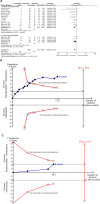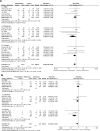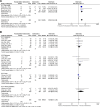Penehyclidine combined with antiemetics for preventing postoperative nausea and vomiting: A meta-analysis of randomized control trials and trial sequential analysis
- PMID: 40550034
- PMCID: PMC12187308
- DOI: 10.1097/MD.0000000000042908
Penehyclidine combined with antiemetics for preventing postoperative nausea and vomiting: A meta-analysis of randomized control trials and trial sequential analysis
Abstract
Background: Postoperative nausea and vomiting (PONV) is one of the most common adverse complications associated with anesthesia and after surgical procedures. PONV is related to patient dissatisfaction and can lead to several postoperative complications. This study aimed to examine the efficacy and safety of penehyclidine combined with antiemetics in preventing PONV.
Methods: We searched English databases (including PubMed, Web of Science, Ovid Medline, Embase and Cochrane Library), Chinese electronic databases (including China National Knowledge Infrastructure, Wanfang, VIP, and Chinese Biomedical Literature) and trial registry databases to find randomized controlled trials researching the clinical validity of penehyclidine combined with antiemetics for PONV. The retrieval time was up to January 2025, without publication date restrictions. Articles published in the English and Chinese languages were considered. The primary outcome was the incidence of PONV within and over 24 hours postoperatively. The secondary outcomes were the incidence of different severities of PONV, incidence of postoperative rescue antiemetic therapy and postoperative complications. Quality assessment was conducted with the Cochrane Collaboration's risk of bias tool and grading of recommendations assessment, development and evaluation method. Subgroup analyses were performed according to the postoperative observation period. Trial sequential analysis was performed to validate the reliability of the primary outcome. Publication bias was assessed by funnel plots and Egger's regression test.
Results: Sixteen randomized controlled trials comprising 1561 participants were included. Compared with the control group, penehyclidine combined with antiemetics provided a lower incidence of PONV (risk ratio [RR]: 0.65; 95% CI: 0.57-0.74; P < .00001; I2 = 11%; low quality), lower incidence of severe PONV over 24 hours postoperatively (RR: 0.29; 95% CI: 0.15-0.56; P = .0003; I2 = 0%; low quality), and a lower incidence of postoperative rescue antiemetic therapy (RR = 0.42, 95% CI: 0.26-0.69; P = .0006; I2 = 58%; low quality). However, it was associated with a higher incidence of dry mouth (RR: 3.10, 95% CI: 2.28-4.20; P < .00001; I2 = 19%; low quality), but did not increase the incidence of other anticholinergic-related complications (RR: 1.08; 95% CI: 0.91-1.28; P = .38; I2 = 2%; low quality).
Conclusion: Compared with antiemetics, penehyclidine combined with antiemetics could provide better prevention efficiency for PONV, with lower incidence of PONV, lower incidence of severe PONV over 24 hours postoperatively and lower incidence of postoperative rescue antiemetic therapy.
Keywords: PONV; meta-analysis; penehyclidine; postoperative nausea and vomiting.
Copyright © 2025 the Author(s). Published by Wolters Kluwer Health, Inc.
Conflict of interest statement
The authors have no funding and conflicts of interest to disclose.
Figures









Similar articles
-
Stimulation of the wrist acupuncture point PC6 for preventing postoperative nausea and vomiting.Cochrane Database Syst Rev. 2015 Nov 2;2015(11):CD003281. doi: 10.1002/14651858.CD003281.pub4. Cochrane Database Syst Rev. 2015. PMID: 26522652 Free PMC article.
-
Drugs for preventing postoperative nausea and vomiting in adults after general anaesthesia: a network meta-analysis.Cochrane Database Syst Rev. 2020 Oct 19;10(10):CD012859. doi: 10.1002/14651858.CD012859.pub2. Cochrane Database Syst Rev. 2020. PMID: 33075160 Free PMC article.
-
Aromatherapy for treatment of postoperative nausea and vomiting.Cochrane Database Syst Rev. 2018 Mar 10;3(3):CD007598. doi: 10.1002/14651858.CD007598.pub3. Cochrane Database Syst Rev. 2018. PMID: 29523018 Free PMC article.
-
Transdermal scopolamine for the prevention of postoperative nausea and vomiting: a systematic review and meta-analysis.Clin Ther. 2010 Nov;32(12):1987-2002. doi: 10.1016/j.clinthera.2010.11.014. Clin Ther. 2010. PMID: 21118734
-
Stimulation of the wrist acupuncture point P6 for preventing postoperative nausea and vomiting.Cochrane Database Syst Rev. 2009 Apr 15;(2):CD003281. doi: 10.1002/14651858.CD003281.pub3. Cochrane Database Syst Rev. 2009. Update in: Cochrane Database Syst Rev. 2015 Nov 02;(11):CD003281. doi: 10.1002/14651858.CD003281.pub4. PMID: 19370583 Free PMC article. Updated.
References
-
- Pierre S, Whelan R. Nausea and vomiting after surgery. Continu Educ Anaesth Crit Care Pain. 2012;13:28–32.
-
- Apfel CC, Heidrich FM, Jukar-Rao S, et al. Evidence-based analysis of risk factors for postoperative nausea and vomiting. Br J Anaesth. 2012;109:742–53. - PubMed
-
- Lehmann M, Monte K, Barach P, Kindler CH. Postoperative patient complaints: a prospective interview study of 12,276 patients. J Clin Anesth. 2010;22:13–21. - PubMed
-
- Eberhart LH, Mauch M, Morin AM, Wulf H, Geldner G. Impact of a multimodal anti-emetic prophylaxis on patient satisfaction in high-risk patients for postoperative nausea and vomiting. Anaesthesia. 2002;57:1022–7. - PubMed
-
- Myles PS, Williams DL, Hendrata M, Anderson H, Weeks AM. Patient satisfaction after anaesthesia and surgery: results of a prospective survey of 10,811 patients. Br J Anaesth. 2000;84:6–10. - PubMed
Publication types
MeSH terms
Substances
LinkOut - more resources
Full Text Sources

